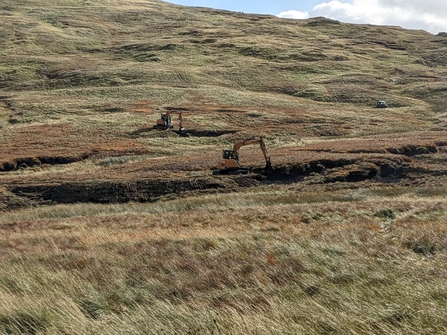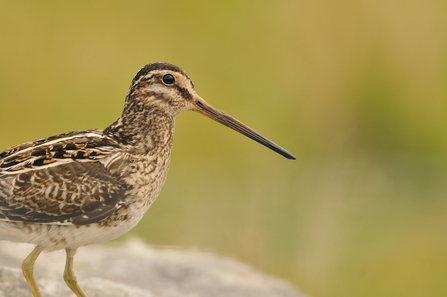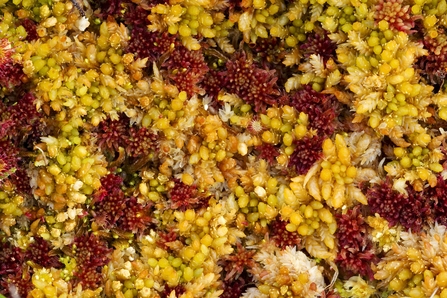
New £2.4m peatland partnership will see heavily-degraded peat bogs restored across Lancashire and Cumbria © Cumbria Wildlife Trust

New £2.4m peatland partnership will see heavily-degraded peat bogs restored across Lancashire and Cumbria © Cumbria Wildlife Trust

Healthy peatlands can support an array of wildlife, including snipe © Fergus Gill/2020VISION
A new £2.4m[1] peatland partnership will see heavily-degraded peat bogs restored across Lancashire and Cumbria, creating healthier habitats in the north of England and bringing the UK closer to its 2050 Net Zero goal.
Coordinated by the National Trust, a partnership of landowners, charities and conservation organisations including Cumbria Wildlife Trust, the Forest of Bowland AONB, and United Utilities will restore 1,063 hectares (2626 acres) of degraded peat at 10 sites in the North West.[2]
It is one of the latest additions to the Great North Bog, a £9.3m peatland restoration initiative developed by the North Pennines AONB Partnership, the Yorkshire Peat Partnership and the Moors for the Future Partnership. The Great North Bog is a landscape-scale approach to upland peatland restoration and conservation across nearly 700,000 hectares (1,729,737 acres) of peatland soils in the Protected Landscapes of northern England, with the potential to stretch from the Peak District to Northumberland.
With funding from Natural England’s Nature for Climate Peatland Grant Scheme, this new partnership will restore some of the most damaged upland peat sites in the North West and prevent an estimated 69,693 tonnes of greenhouse gas being released into the atmosphere by 2050.
Nearly all (92 per cent) of England’s upland peatlands are in the north of England, storing 400 million tonnes of carbon. Healthy peatlands sequester carbon and play a vital role in tackling the climate crisis, but degraded peat emits carbon into the atmosphere, contributing to climate change.
Mike Innerdale, regional director – North region at the National Trust, said: “We know that restoring degraded upland peat in the North of England is absolutely key to reaching the government’s Net Zero goal. The Great North Bog partnership is at the heart of this, with a coalition of landowners, commoners, conservation organisations and communities coming together to bring their expertise and resource to tackle this long-overdue challenge and address the climate crisis.”
Restoration methods will include blocking drains to re-wet the ground, stabilising and revegetating bare peat to reduce erosion, and introducing sphagnum moss to start rebuilding the lost peat.
Heidi Buck, Peatland Officer at Cumbria Wildlife Trust said: “Thanks to this grant, we'll be able to start work on six important upland peatland sites in Cumbria. We'll bring machinery on to the degraded sites to stabilise eroded areas and to create features, to rewet and restore the important peatbog vegetation.
“We'll plant Sphagnum moss, an important peat-forming species, on sites where there isn't much left, to ensure that the carbon trapped within the sites is secure. This will also help to slow the flow of water from the hills and create vital habitats for important species including northern eggar and emperor moths, merlin and peregrine falcon.”
As around 95 per cent of the peatland habitats in Cumbria and the Forest of Bowland are currently in poor condition, this partnership aims to re-start the carbon capture process and stop the release of greenhouse gases from the peat. Once fully restored, the peatland sites are expected to sequester over 8,000 tonnes of CO2 from the atmosphere every year.[3]
Alongside helping to tackle climate change, restoring blanket bog will improve priority habitat for wildlife, safeguarding protected bird species like merlin, hen harrier, and curlew.
Re-wetting these sponge-like peat bogs will also improve water quality for local people in Cumbria and Lancashire, slowing the flow of water during periods of heavy rain and reducing the risk of flooding for communities downstream.[4]
Mike added: “We’re thrilled to be part of this project to restore these peatland sites in Cumbria and Lancashire, which will see long-lasting impacts for people and nature in the North West.”
Pete Wilson, Catchment Partnership Officer, from United Utilities, said: “We are delighted to be supporting this important project by providing additional funding to restore peatland in parts of Cumbria and Lancashire. As a company we have committed to becoming net zero by 2030 and restoring 1,000 hectares (2471 acres) of peat bog.
“Projects like this will go some way to meeting that ambition and it is also important to us from an operational perspective. As well as improving the quality of the water that reaches our reservoirs by acting as a filter, peat bogs can also act as a natural flood management system alleviating pressure on the sewer system during periods of heavy rainfall.”
Restoration work on these 10 sites has already begun and will run until 2025, with partners and landowners continuing to work together beyond the project to ensure that these peatlands are cared for in the long term.

We'll be planting Sphagnum moss, an important peatland-forming species © Mark Hamblin/2020VISION
Peatland facts:
How have the UK’s upland peatlands become damaged?
Healthy peat bogs store carbon, provide habitat for protected wildlife, prevent floods, improve water quality, and even help our archaeologists understand the past, thanks to their amazing ability to preserve plants, wildlife, and artefacts that have become submerged in peat. But peat bogs need to be wet to do all of this.
For centuries, peat and peatland vegetation have been cultivated, drained, and degraded. There is no single cause of peatland degradation, but common factors include:
[1] Funding for this partnership project includes a Restoration Grant from Natural England’s Nature for Climate Peatland Scheme (£1,790,908.47) with additional funding and value in-kind from Lancashire County Council, United Utilities, Cumbria Wildlife Trust, Grosvenor’s Abbeystead Estate, Lowther Estates and the National Trust (to the value of £603,956.62). Learn more about the Nature for Climate Peatland Scheme at www.gov.uk/guidance/nature-for-climate-peatland-grant-scheme
[2] Six peatland sites in Cumbria will be restored, in partnership with Cumbria Wildlife Trust:
Four sites in the Forest of Bowland AONB with be restored, in partnership with Lancashire County Council:
[3] Information based on data from surveys carried out by Cumbria Peat Partnership and Lancashire Peat Partnership, alongside data from Natural England’s carbon calculator. For more information see www.gov.uk/guidance/carbon-calculator
[4] This North West partnership will see 1,063 hectares of peatland restored in areas that are in a catchment upstream of a community at risk of flooding. Restored peat can act as a ‘giant sponge’, holding water in upland sites during periods of heavy rain and reducing the risk of floods downstream. For another example of this work in action in the North West, see: www.manchestereveningnews.co.uk/news/greater-manchester-news/giant-sponge-moorland-climate-change-21234655